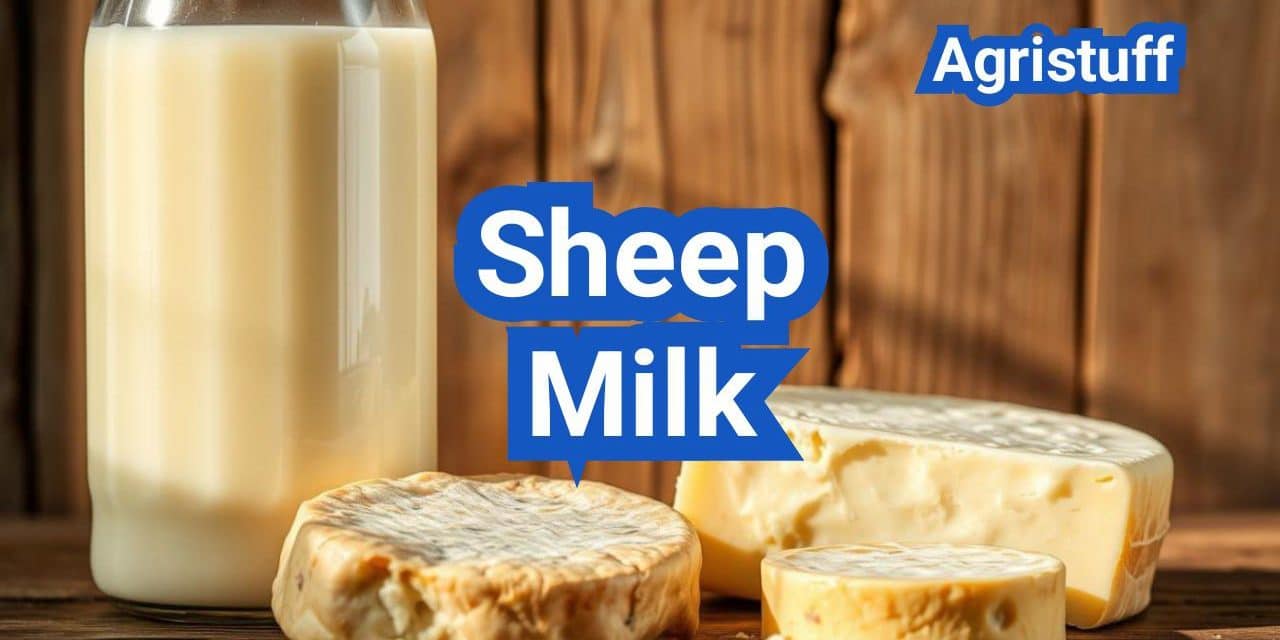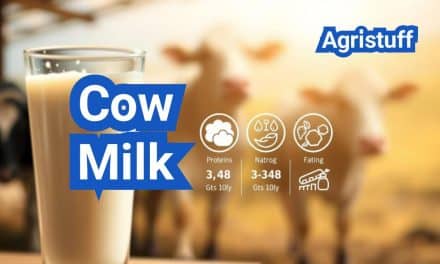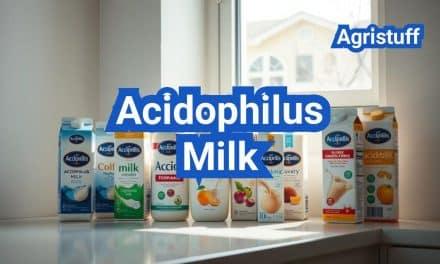Rich in nutrients, sheep milk is gaining popularity for its health benefits and diverse dairy products. Unlike cow’s milk, it contains a higher concentration of certain nutrients, making it a sought-after alternative.
The nutritional profile of sheep milk is impressive, with high levels of protein, calcium, and vitamins. It’s used to produce a variety of cheeses, yogurts, and other dairy products that are rich in flavor and nutritional value.
As interest in sheep milk grows, so does its availability in the U.S. market. Consumers can now find a range of sheep milk products in stores and online, making it easier to incorporate these nutritious foods into their diets.
Key Takeaways
- Sheep milk is rich in nutrients, including protein, calcium, and vitamins.
- It’s used to produce a variety of dairy products, such as cheese and yogurt.
- The U.S. availability of sheep milk products is increasing.
- Sheep milk is considered a healthier alternative to cow’s milk by some.
- Sheep milk products are diverse and rich in flavor.
What is Sheep Milk and Why It Matters
The history of sheep milking is as old as the domestication of sheep itself, playing a crucial role in the development of dairy products. Sheep milk has been a vital component of various cultures, particularly in regions where cattle farming was not prevalent. As a rich source of nutrition, it has been consumed for centuries, contributing significantly to the dietary habits of many communities around the world.
Origins and Historical Significance
Sheep were among the first animals to be domesticated by humans, with evidence suggesting that sheep milking dates back to around 7,000 years ago in the Near East. The practice spread throughout the Mediterranean region, where it became integral to the local cuisine and economy. Sheep milk was not only consumed fresh but also used to produce cheese, yogurt, and butter, products that were essential for sustenance and trade. The historical significance of sheep milk is highlighted by its mention in ancient texts and its role in traditional practices.
“The production of sheep milk cheese is an ancient tradition that has been passed down through generations, with some of the world’s most renowned cheeses originating from sheep milk.”
Global Production and Consumption
Today, sheep milk production is a significant dairy industry in many parts of the world, with countries like Greece, Italy, and Spain being among the top producers. The global consumption of sheep milk and its products is on the rise, driven by increasing demand for specialty dairy products. The nutritional benefits of sheep milk, including its high content of proteins and minerals, have contributed to its growing popularity. As global consumers become more aware of the diverse types of milk and their benefits, sheep milk is gaining recognition for its unique qualities and traditional heritage.
The global sheep milk industry is characterized by a mix of traditional farming practices and modern dairy technology. While traditional methods are still prevalent, many farms are adopting advanced techniques to improve milk quality and yield. This blend of old and new practices is crucial for meeting the growing demand for sheep milk products while maintaining their authenticity and quality.
The Complete Nutritional Profile of Sheep Milk

With its high content of proteins, fats, vitamins, and minerals, sheep milk stands out as a nutrient-dense beverage. This characteristic makes it an excellent choice for those seeking to enhance their dietary intake of essential nutrients.
Protein and Fat Content
Sheep milk is particularly notable for its high protein content, which is crucial for muscle repair and growth. The protein in sheep milk is of high quality, containing all essential amino acids necessary for human health. Additionally, sheep milk contains a significant amount of fat, which is important for the absorption of fat-soluble vitamins and providing energy.
The fat content in sheep milk is also characterized by its rich composition of fatty acids, including conjugated linoleic acid (CLA), which has been associated with various health benefits. The presence of these fatty acids contributes to the nutritional and culinary value of sheep milk and its products.
Vitamins and Minerals
Sheep milk is an excellent source of several vitamins and minerals, making it a valuable component of a balanced diet. It is particularly rich in calcium, phosphorus, and vitamin B12, nutrients that are crucial for bone health, energy production, and neurological function.
The vitamin and mineral profile of sheep milk supports various bodily functions, from bone mineralization to the maintenance of healthy skin and hair. Its richness in vitamins A and E also provides antioxidant benefits, helping to protect cells from damage.
Bioactive Compounds
Beyond its nutritional content, sheep milk contains a range of bioactive compounds that have been shown to have positive effects on health. These include immunoglobulins, which can support immune function, and oligosaccharides, which may have prebiotic properties.
The presence of these bioactive compounds in sheep milk adds to its nutritional value, potentially offering benefits that extend beyond basic nutrition to support overall health and well-being.
Health Benefits of Sheep Milk
Rich in essential nutrients, sheep milk is associated with various health benefits, including better digestive health and stronger bones. Its unique nutritional profile makes it an excellent choice for those looking to enhance their overall well-being.
Digestive Health Advantages
Sheep milk contains smaller fat molecules compared to cow milk, making it easier to digest for some individuals. This characteristic, combined with its rich content of probiotics, can support gut health and potentially alleviate symptoms of digestive disorders.
The high-quality protein in sheep milk is also beneficial for digestive health, as it provides essential amino acids necessary for the repair and maintenance of the digestive tract.
Immune System Support
The immune system benefits from the consumption of sheep milk due to its high content of immunoglobulins and other immune-boosting compounds. These components help in enhancing the body’s natural defense mechanisms, potentially reducing the risk of infections.
Furthermore, sheep milk is rich in vitamins and minerals that play a crucial role in supporting immune function, making it a valuable addition to a diet aimed at maintaining or improving immune health.
Bone Health and Calcium Benefits
Sheep milk is an excellent source of calcium, a mineral crucial for bone health. The calcium in sheep milk, along with other nutrients like phosphorus and vitamin D, contributes to the development and maintenance of strong bones and teeth.
Regular consumption of sheep milk can help in maintaining bone density, potentially reducing the risk of osteoporosis and fractures, especially in older adults.
Sheep Milk vs. Cow Milk: Understanding the Differences
Sheep milk and cow milk differ significantly in terms of their nutritional value, culinary applications, and ecological footprint. This comparison is crucial for consumers who are deciding which type of milk to include in their diet.
Nutritional Comparison
The nutritional profiles of sheep milk and cow milk vary considerably. Sheep milk contains more calories, fat, and protein compared to cow milk. It is also richer in vitamins and minerals such as calcium, phosphorus, and potassium.
| Nutrient | Sheep Milk (per 100ml) | Cow Milk (per 100ml) |
|---|---|---|
| Calories | 108 | 64 |
| Protein | 5.9g | 3.2g |
| Fat | 7g | 3.5g |
| Calcium | 193mg | 120mg |
Taste and Culinary Applications
The taste of sheep milk is often described as richer and creamier than cow milk, making it ideal for producing cheeses and yogurts. Its higher fat content also makes it more suitable for cooking and baking applications where richness is desired.
Culinary Uses: Sheep milk is preferred for making cheeses like Pecorino Romano and Roquefort due to its rich flavor and high fat content. Cow milk, on the other hand, is more versatile and used in a wide range of dairy products.
Environmental Impact Considerations
The environmental impact of sheep milk production is generally considered to be lower than that of cow milk, mainly due to the differences in feed requirements and methane production. Sheep require less intensive farming practices and can thrive on less fertile land.
- Sheep milk production tends to have a lower carbon footprint.
- Sheep are more adaptable to grazing on marginal lands, reducing the need for intensive agricultural practices.
- Cow milk production often involves larger scale dairy farming, which can have a higher environmental impact.
In conclusion, the choice between sheep milk and cow milk depends on nutritional needs, culinary preferences, and environmental considerations. Understanding these differences can help consumers make informed decisions about their dairy choices.
Sheep Milk vs. Goat Milk: Which to Choose?

Sheep milk and goat milk are both popular alternatives to cow milk, but they have distinct differences that may make one more suitable to your needs than the other. Understanding these differences is key to making an informed decision.
Flavor and Texture Differences
The flavor and texture of sheep and goat milk vary significantly. Sheep milk has a richer, creamier texture and a sweeter, more nutty flavor, making it ideal for producing cheeses and yogurts. Goat milk, on the other hand, has a lighter texture and a tangier taste, which some people prefer for drinking or using in recipes.
The texture difference is largely due to the fat molecule size and the natural homogenization process in sheep milk, which makes it more suitable for certain dairy products. Goat milk, with its smaller fat molecules, is often easier to digest for those with sensitive stomachs.
Nutritional Distinctions
Nutritionally, both sheep and goat milk are superior to cow milk in several aspects. Sheep milk contains higher levels of protein, calcium, and vitamins, making it a nutrient-dense choice. Goat milk is also rich in nutrients, with a higher concentration of certain minerals like potassium and magnesium compared to cow milk.
However, sheep milk has a higher calorie and fat content than goat milk, which can be a consideration for those monitoring their diet. The choice between the two may depend on your nutritional needs and preferences.
Best Uses for Each
Sheep milk is particularly well-suited for cheese production due to its high fat content and rich flavor. It’s used in making traditional cheeses like Pecorino Romano and Roquefort. Goat milk, with its lighter taste and easier digestibility, is often consumed directly or used in yogurts and soft cheeses.
Ultimately, the choice between sheep and goat milk depends on your intended use, nutritional requirements, and personal taste preferences. Both offer unique benefits and can be a valuable addition to a diverse diet.
Sheep Milk vs. Buffalo Milk: A Comparative Analysis
Comparing sheep milk and buffalo milk reveals differences in their nutritional content and applications in dairy products. Both types of milk are rich in nutrients but have distinct compositions that cater to various dietary needs and preferences.
Composition and Nutritional Variances
Sheep milk is known for its high content of protein, fat, and certain minerals like calcium and phosphorus. In contrast, buffalo milk has a higher fat content and is rich in vitamins and minerals such as vitamin A and potassium.
Nutritional Comparison: Sheep milk contains approximately 6.9% fat, 5.5% protein, and 4.8% lactose, while buffalo milk contains around 7.5% fat, 4.3% protein, and 4.9% lactose.
Availability and Product Applications
Sheep milk is often used in the production of specialty cheeses like Pecorino Romano and Manchego, due to its rich flavor and high nutritional content. Buffalo milk, on the other hand, is famously used to make Mozzarella di Bufala, a protected designation of origin cheese in the European Union.
Product Applications: The choice between sheep milk and buffalo milk for dairy products depends on the desired flavor, texture, and nutritional profile. Sheep milk is ideal for cheese production due to its high protein and fat content, while buffalo milk is preferred for its creamy texture and rich flavor in products like mozzarella.
As noted by dairy experts, “The unique characteristics of sheep and buffalo milk make them suitable for different types of dairy products, catering to a wide range of consumer preferences.”
“The nutritional and sensory properties of sheep and buffalo milk make them invaluable in the production of high-quality dairy products.”
How to Incorporate Sheep Milk into Your Diet

Exploring the world of sheep milk can open up new possibilities for culinary enjoyment and nutritional benefits. Sheep milk is rich in nutrients and can be consumed in various forms, making it easy to incorporate into daily meals.
Starting with Sheep Milk Products
For those new to sheep milk, starting with sheep milk products is a great way to begin. Sheep milk cheese, yogurt, and ice cream are popular products that can be easily found in specialty stores or online. These products not only offer a delicious way to enjoy sheep milk but also provide a convenient entry point into its nutritional benefits.
- Try sheep milk yogurt as a base for smoothies or as a topping for oatmeal or fruit.
- Experiment with sheep milk cheese in salads, pasta dishes, or as a snack on its own.
- Indulge in sheep milk ice cream for a rich and creamy dessert.
Substituting in Recipes
Sheep milk can be used as a substitute in many recipes that call for cow or goat milk. When substituting, keep in mind that sheep milk has a richer flavor and higher fat content, which can affect the overall taste and texture of the dish.
Some ideas for substituting sheep milk in recipes include:
- Using sheep milk in place of cow milk in baking recipes, such as cakes and muffins.
- Adding sheep milk to soups and sauces for an extra layer of creaminess.
- Making creamy desserts like custards and puddings with sheep milk.
Recommended Daily Intake
The recommended daily intake of sheep milk can vary based on individual nutritional needs and health goals. Generally, consuming 1-2 cups of sheep milk or its products per day is considered a healthy addition to a balanced diet.
It’s essential to consult with a healthcare professional or a registered dietitian to determine the best intake level for your specific needs.
Lactose Intolerance and Sheep Milk: What You Need to Know

Sheep milk has been gaining attention for its potential to be more digestible for those with lactose intolerance. This section explores the relationship between lactose intolerance and sheep milk, including its digestibility, scientific research, and tips for those transitioning to sheep milk.
Why Sheep Milk May Be More Digestible
Sheep milk contains a different type of lactose and protein structure compared to cow milk, which may make it easier for some individuals with lactose intolerance to digest.
Sheep milk has a unique composition that could potentially benefit those with lactose intolerance. The fat molecules in sheep milk are smaller, and the protein structure is different, which may aid in easier digestion.
Scientific Research on Lactose Content
Research into the lactose content of sheep milk has shown promising results for those with lactose intolerance. Studies have indicated that the lactose in sheep milk may be more easily tolerated due to its specific composition.
A study published in the Journal of Dairy Science found that the lactose content in sheep milk, while still present, is accompanied by other components that may facilitate its digestion.
Transitioning Tips for Sensitive Individuals
For those with lactose intolerance looking to incorporate sheep milk into their diet, starting with small amounts and monitoring the body’s response is advisable.
- Begin with a small serving size to test tolerance.
- Gradually increase the amount over time if no adverse reactions occur.
- Consider consuming sheep milk products like cheese or yogurt, which may be easier to digest than liquid milk.
Navigating Sheep Milk Allergies and Cross-Reactivity
Navigating the world of sheep milk requires knowledge not only of its benefits but also of its potential to cause allergic reactions. As with any dairy product, some individuals may experience an immune response to sheep milk, ranging from mild discomfort to severe reactions.
Identifying Sheep Milk Allergies
Identifying a sheep milk allergy involves recognizing the symptoms, which can include digestive issues, skin rashes, and respiratory problems. If you suspect an allergy, consulting a healthcare professional is essential for proper diagnosis and guidance.
The diagnosis often involves a combination of medical history, elimination diets, and potentially, allergy testing. It’s crucial to differentiate between an allergy and intolerance, as the latter is typically related to lactose digestion issues rather than an immune response.
Cross-Reactivity with Other Dairy
Cross-reactivity occurs when the immune system mistakes proteins in different types of milk for the same allergen. Research indicates that individuals allergic to cow’s milk may also react to sheep milk due to similarities in milk proteins. However, the extent of cross-reactivity can vary.
| Milk Type | Protein Similarity to Cow Milk | Potential for Cross-Reactivity |
|---|---|---|
| Sheep Milk | High | High |
| Goat Milk | Moderate | Moderate |
| Buffalo Milk | High | High |
Alternative Options
For those allergic to sheep milk or experiencing cross-reactivity, there are alternative dairy and non-dairy options available. Non-dairy milks made from almonds, soy, oats, and coconut are popular substitutes, offering a range of nutritional profiles and tastes.
When selecting an alternative, consider the nutritional content, especially if you’re replacing sheep milk for its nutritional benefits. Some non-dairy milks are fortified with calcium, vitamins, and proteins to more closely match dairy milk’s nutritional profile.
In conclusion, while sheep milk allergies and cross-reactivity are significant concerns, awareness and understanding can help manage these issues. By identifying allergies accurately and exploring alternative options, individuals can continue to enjoy the nutritional benefits of dairy or dairy-like products.
Exploring the World of Sheep Milk Cheeses

With a history that spans centuries, sheep milk cheeses continue to captivate cheese enthusiasts with their unique taste profiles and production techniques. Sheep milk is rich in nutrients and has properties that make it ideal for cheese production, resulting in a diverse range of cheeses that are enjoyed globally.
Traditional Production Methods
The production of sheep milk cheeses involves traditional methods that have been passed down through generations. These methods vary by region but generally involve the careful selection of milk from sheep breeds known for their high-quality milk. The milk is then curdled, shaped, and aged to perfection.
Curdling and shaping are critical steps in cheese production. The curdling process involves adding rennet to the milk to separate it into curds and whey. The curds are then shaped into their desired form, which can range from wheels to blocks.
Aging Processes and Flavor Development
The aging process is crucial for the development of the cheese’s flavor and texture. Sheep milk cheeses can be aged for varying lengths of time, from a few months to several years. During this time, the cheese may be turned regularly, rubbed with brine, or coated with wax to prevent drying out.
Aging contributes significantly to the flavor profile of the cheese. For example, a young sheep milk cheese might be mild and creamy, while an aged cheese can be sharp and nutty. The aging process allows for the development of complex flavors and aromas that are characteristic of many sheep milk cheeses.
Categories of Sheep Milk Cheeses
Sheep milk cheeses can be categorized into several types based on their texture, aging process, and production methods. These categories include fresh cheeses, soft cheeses, semi-hard cheeses, and hard cheeses. Each category has its own unique characteristics and uses in cooking.
- Fresh cheeses are young and have a mild flavor.
- Soft cheeses are creamy and often spreadable.
- Semi-hard cheeses offer a balance between texture and flavor.
- Hard cheeses are aged and have a robust flavor.
Understanding these categories can help in selecting the right cheese for various culinary applications, from cooking and baking to serving as a standalone delicacy.
Guide to Iconic Sheep Milk Cheeses

Among the numerous types of cheese made from sheep’s milk, a few have achieved iconic status due to their distinct characteristics and historical significance. These cheeses not only represent the pinnacle of dairy craftsmanship but also embody the rich cultural heritage of their regions.
Manchego: Spain’s Culinary Treasure
Manchego cheese, originating from La Mancha, Spain, is one of the most renowned sheep milk cheeses worldwide. Its rich, nutty flavor and firm texture make it a favorite among cheese connoisseurs. Manchego is often served as a tapas or grated over local dishes, showcasing its versatility.
Pecorino Romano: Italy’s Ancient Cheese
Pecorino Romano is another iconic cheese, with roots tracing back to ancient Rome. Made from sheep’s milk, it’s known for its sharp, salty flavor and is a staple in Italian cuisine, often grated over pasta dishes like carbonara and cacio e pepe.
Roquefort: The King of Blue Cheeses
Roquefort, a French blue cheese, is made from sheep’s milk and is known for its distinctive veining and robust flavor. This cheese is a protected designation of origin (PDO) product, meaning it must be produced in the Roquefort region to bear the name.
American Sheep Milk Cheese Innovations
The United States has seen a rise in sheep milk cheese production, with many American dairy farms innovating traditional recipes. American sheep milk cheese innovations blend classic techniques with local flavors, resulting in unique products that are gaining recognition globally.
These iconic sheep milk cheeses, along with American innovations, highlight the diversity and richness of sheep milk dairy products. Whether you’re a cheese aficionado or just discovering the world of sheep milk cheeses, there’s a wealth of flavors and textures to explore.
Beyond Cheese: Discovering Other Sheep Milk Products

The versatility of sheep milk extends far beyond cheese, offering a range of products that are worth exploring. Sheep milk is rich in nutrients and can be transformed into various dairy delights that cater to different tastes and dietary needs.
How to Select Quality Sheep Milk Yogurt
When it comes to sheep milk yogurt, quality is paramount. Look for products that are made from fresh, pasture-raised sheep milk, as these tend to have a richer flavor and better nutritional profile. Check the label for information on the milk source and production methods. Additionally, consider the fat content and whether the yogurt is flavored or plain.
Sheep milk yogurt is known for its creamy texture and tangy taste. It’s an excellent source of protein and probiotics, making it a great option for those looking to support their digestive health. When selecting a brand, opt for those that are transparent about their sourcing and production processes.
Finding and Enjoying Sheep Milk Ice Cream
Sheep milk ice cream is a decadent treat that offers a unique taste experience. To find high-quality sheep milk ice cream, look for producers that use fresh, local milk and minimal additives. The flavor profile can vary significantly depending on the production methods, so it’s worth trying different brands to find one that suits your taste.
Enjoy sheep milk ice cream as a dessert or a snack. It’s particularly appealing to those who enjoy rich, creamy textures. Some producers also offer unique flavors that incorporate local ingredients, making it a great way to experience local cuisine.
Specialty Products Worth Trying
Beyond yogurt and ice cream, sheep milk is used to create a variety of specialty dairy products. These can include sheep milk kefir, which offers a tangy, probiotic-rich beverage option, and sheep milk butter, which is prized for its rich flavor and high nutritional content.
Exploring these specialty products can add variety to your diet and provide a range of nutritional benefits. When trying new products, consider the production methods and ingredient lists to ensure they align with your dietary preferences and needs.
Pasteurized vs. Raw Sheep Milk: Safety and Selection Guide

Understanding the differences between pasteurized and raw sheep milk is crucial for making informed dietary choices. Both types of milk have their own set of benefits and drawbacks, particularly concerning safety and nutritional content.
Understanding the Differences
Pasteurized sheep milk is heated to a high temperature to kill harmful bacteria, extending its shelf life. In contrast, raw sheep milk is not heat-treated, preserving its natural enzymes and some argue, its nutritional profile. The choice between the two often comes down to personal preference and individual health considerations.
Pasteurization Process: The pasteurization process involves heating the milk to at least 161°F for at least 15 seconds, followed by rapid cooling. This process effectively reduces the risk of milk-borne pathogens.
Raw Milk Considerations: Raw sheep milk retains its natural state, which some consumers prefer for its potential health benefits and richer flavor. However, it carries a higher risk of containing harmful bacteria like Salmonella and E. coli.
Safety Considerations and Regulations
The safety of sheep milk, whether pasteurized or raw, is a paramount concern. Regulations regarding the sale and consumption of raw milk vary by state in the U.S., with some states imposing stricter controls than others.
- Regulations on raw milk sales and consumption differ significantly across the United States.
- Pasteurized milk is generally considered safer due to the elimination of pathogens.
- Raw milk enthusiasts argue that the benefits of raw milk outweigh the risks, provided it is sourced from reputable farms.
Making the Right Choice for Your Needs
When deciding between pasteurized and raw sheep milk, consider your health status, personal preferences, and the source of the milk. For individuals with weakened immune systems, pasteurized milk is often recommended.
| Consideration | Pasteurized Sheep Milk | Raw Sheep Milk |
|---|---|---|
| Safety | Reduced risk of pathogens | Higher risk of pathogens |
| Nutritional Content | Some loss of natural enzymes | Retention of natural enzymes |
| Availability | Widely available | Limited availability, varies by state |
Ultimately, the decision between pasteurized and raw sheep milk should be based on a careful consideration of the benefits and risks associated with each.
Where to Buy Sheep Milk and Products in the United States
With the growing interest in sheep milk, locating a reliable supplier is essential for enthusiasts. Sheep milk and its products are available through various channels, making it easier for consumers to access them.
Specialty and Natural Food Stores
Many specialty and natural food stores now carry sheep milk products, recognizing the growing demand. These stores often source their products from local farms, ensuring freshness and quality. When shopping at these stores, look for products that are clearly labeled with their origin and nutritional information.
Online Retailers and Delivery Services
The rise of online shopping has made it easier than ever to purchase sheep milk products. Online retailers and delivery services offer a wide range of products, from raw sheep milk to artisanal cheeses. Some online platforms even allow direct purchases from farmers, providing consumers with a direct link to the source.
Benefits of Buying Online:
- Convenience of shopping from home
- Access to a wider range of products
- Direct delivery to your doorstep
Farmers Markets and Direct Farm Sales
Farmers markets remain a vibrant channel for purchasing sheep milk products directly from the producers. Many sheep dairy farms participate in local farmers markets, offering consumers the opportunity to buy fresh products and learn about the production process. Direct farm sales also provide a chance to visit the farms, understand the farming practices, and purchase products directly.
By exploring these options, consumers can find high-quality sheep milk products that suit their dietary needs and preferences. Whether you’re looking for a specific type of cheese or wanting to try raw sheep milk, the U.S. market offers a variety of choices.
Supporting American Sheep Dairy Farms
The significance of American sheep dairy farms extends beyond their products to include environmental and social benefits. These farms contribute to the local economy, preserve traditional farming practices, and promote sustainable agriculture.
Notable Sheep Dairy Operations in the USA
Several sheep dairy farms across the United States are making significant contributions to the industry. For instance, farms like Storm Hill Farm in New York and Meadow Creek Dairy in Washington are known for their high-quality sheep milk products and innovative farming practices.
These farms not only produce exceptional dairy products but also serve as models for sustainable and responsible farming methods. By visiting such farms, consumers can gain a deeper understanding of the effort and care that goes into producing sheep milk and its derivatives.
Sustainable Farming Practices
Sustainable farming practices are at the heart of many American sheep dairy farms. These practices include rotational grazing, which helps maintain soil health and biodiversity, and the use of renewable energy sources to power farm operations.
By adopting sustainable practices, sheep dairy farms can reduce their environmental footprint while maintaining high standards of animal welfare. This approach not only benefits the environment but also results in healthier animals and better-quality milk.
Farm Tours and Direct Purchasing
One of the best ways to support American sheep dairy farms is by visiting them. Many farms offer tours, allowing consumers to see firsthand how sheep milk is produced and learn about the farming practices employed.
Direct purchasing is another effective way to support these farms. By buying products directly from the farm or through their websites, consumers can ensure that their money is going directly to the farmers. This support helps sustain the farms and enables them to continue producing high-quality products.
Furthermore, engaging with local sheep dairy farms through farm tours and direct purchasing can foster a stronger connection between consumers and the agricultural community, promoting a more sustainable food system.
Embracing the Benefits of Sheep Milk
Sheep milk offers a multitude of nutritional benefits, making it a valuable addition to a healthy diet. Rich in protein, vitamins, and minerals, sheep milk is used in a variety of dairy products, from cheese and yogurt to ice cream.
Embracing sheep milk means exploring its versatility in culinary applications, whether it’s substituting cow milk in recipes or enjoying artisanal sheep milk cheeses like Manchego and Pecorino Romano.
The benefits of sheep milk extend beyond nutrition; supporting American sheep dairy farms promotes sustainable farming practices and local economies.
As consumers become more aware of the nutritional benefits and dairy products made from sheep milk, its popularity is likely to grow, driving demand for high-quality, locally sourced products.
FAQ
What are the nutritional benefits of sheep milk?
Sheep milk is rich in nutrients, including high-quality protein, vitamins, and minerals. It is particularly known for its high content of calcium, phosphorus, and vitamins B and E, making it a nutritious choice for those looking to enhance their diet.
How does sheep milk compare to cow milk in terms of nutrition?
Sheep milk has a higher concentration of fat, protein, and certain vitamins and minerals compared to cow milk. This makes it more calorie-dense but also richer in nutrients.
Is sheep milk suitable for individuals with lactose intolerance?
Some individuals with lactose intolerance may find sheep milk more digestible than cow milk due to its different lactose composition and the presence of certain fatty acids. However, it’s still important for those with lactose intolerance to consume it cautiously.
What are some popular sheep milk cheeses?
Popular sheep milk cheeses include Manchego from Spain, Pecorino Romano from Italy, and Roquefort, a French blue cheese. These cheeses are renowned for their distinct flavors and textures.
Can I buy sheep milk and sheep milk products in the United States?
Yes, sheep milk and various sheep milk products are available in the United States. You can find them in specialty stores, some supermarkets, online retailers, and directly from dairy farms.
What is the difference between pasteurized and raw sheep milk?
Pasteurized sheep milk has been heat-treated to kill bacteria, whereas raw sheep milk has not. While pasteurization enhances safety, raw sheep milk is prized for its rich flavor and potential health benefits, though it carries a higher risk of containing harmful bacteria.
How can I support American sheep dairy farms?
Supporting American sheep dairy farms can be achieved by purchasing their products directly, visiting farm tours, and promoting sustainable farming practices. This not only helps the local economy but also encourages the continuation of traditional dairy farming methods.
Are there any sheep milk products suitable for babies and young children?
Sheep milk and its products, such as yogurt and cheese, can be nutritious for children. However, it’s essential to consult with a healthcare provider before introducing any new dairy product into a child’s diet, especially if they have known allergies or sensitivities.
How do I identify if I’m allergic to sheep milk?
Symptoms of a sheep milk allergy can include digestive issues, skin rashes, and respiratory problems. If you suspect an allergy, it’s crucial to consult with a healthcare professional for proper diagnosis and advice.
Can sheep milk be used in cooking and baking?
Absolutely, sheep milk can be used in a variety of recipes, from savory dishes to baked goods. Its rich flavor and nutritional profile make it a versatile ingredient for many culinary applications.
Conclusion of: Sheep Milk In USA
What makes sheep milk worth your attention in the U.S.?
Sheep milk is naturally rich, creamy, and nutrient-dense, making it a standout choice for people who want more protein and calcium per cup along with a luxurious texture; in this U.S.-focused guide to sheep milk, you’ll learn how sheep milk compares nutritionally, how sheep milk tastes, which cheeses rely on sheep milk, and where to find sheep milk products near you. USDA FoodData Central
Sheep milk nutrition at a glance (per cup)
Sheep milk typically delivers roughly 265 calories, about 14–15 grams of protein, around 17 grams of fat, and near 13 grams of carbohydrate per 1 cup (≈245 g), which means sheep milk packs more solids (protein + fat) than most cow’s milk styles and helps sheep milk feel more satisfying in smaller portions. MyFoodData: Sheep Milk (USDA-derived)
Why sheep milk feels richer on the palate
Compared with standard cow’s milk, sheep milk contains higher total solids, so sheep milk coats the palate with a thicker, silkier body; that high-solids profile is also why sheep milk excels for cultured products and cheeses that require concentrated protein and butterfat. MyFoodData: Composition Detail
Protein density in sheep milk
Because sheep milk is dense in casein and whey proteins, sheep milk provides complete amino acids that support satiety and muscle repair; this makes sheep milk a practical option for smoothies, hot cocoa, and cooking when you want extra protein without adding powders. USDA-Derived Protein Facts
Calcium, phosphorus, and key minerals in sheep milk
Beyond protein, sheep milk delivers robust levels of calcium and phosphorus—the mineral duo that supports bone and tooth health—plus meaningful potassium and magnesium, so sheep milk can help you reach daily mineral targets with smaller serving sizes. University Hospitals: Sheep Milk Minerals
Fat profile and mouthfeel in sheep milk
Sheep milk’s higher butterfat explains much of sheep milk’s luscious mouthfeel; like other dairy, sheep milk includes both saturated and unsaturated fatty acids—including short- and medium-chain fats that are readily used for energy—contributing to flavor and creaminess. Fatty-Acid Overview
Lactose in sheep milk and tolerance tips
Sheep milk naturally contains lactose, and while some people with lactose intolerance find small portions of sheep milk or aged sheep milk cheeses more tolerable, sheep milk still has lactose and individual tolerance varies—pairing sheep milk with meals and spacing portions can help. NIDDK: Lactose Intolerance Guidance
Allergy considerations: is sheep milk an alternative?
If you have a confirmed cow’s milk protein allergy, sheep milk is generally not a safe alternative due to cross-reactivity among ruminant milks; always discuss sheep milk trials with a board-certified allergist before experimenting with sheep milk products. AAAAI: Food Allergy Practice Parameter
Raw vs. pasteurized sheep milk products
Public-health authorities recommend choosing pasteurized sheep milk and pasteurized sheep milk cheeses to reduce the risk of foodborne illness from pathogens that can be present in raw milk, so if safety is your priority with sheep milk, look for “pasteurized” on labels. CDC: Raw Milk Risks
How sheep milk is regulated for safety in the U.S.
Most states use the FDA’s Grade “A” Pasteurized Milk Ordinance (PMO) as a model for regulating milk sanitation and processing, and sheep milk falls within this framework—meaning properly labeled pasteurized sheep milk adheres to standardized safety practices. FDA: PMO Model Documents
What does sheep milk taste like?
Most people describe sheep milk as clean, mildly sweet, and richly creamy; the higher solids in sheep milk bring a plush body without the sometimes “goaty” notes found in some goat milks, so sheep milk often tastes neutral and crowd-pleasing when fresh and well-handled. Nutrition Clues to Flavor
Popular cheeses made from sheep milk
A remarkable number of the world’s iconic cheeses—Manchego, Roquefort, Pecorino Romano—are made from sheep milk because sheep milk provides the solids and flavors great cheesemaking requires; many are protected by European PDO/AOP standards. American Cheese Society Resources
Manchego: Spain’s benchmark sheep milk cheese
Authentic Manchego comes from La Mancha and is crafted from Manchega sheep milk; young Manchego showcases buttery sweetness while aged styles from sheep milk develop nutty depth and a firm, sliceable texture ideal for snacking and tapas boards. Official Manchego PDO
Roquefort: blue royalty from sheep milk
Roquefort is an AOP blue cheese made from raw sheep milk and ripened in the natural caves of Roquefort-sur-Soulzon, yielding a creamy but boldly savory blue whose intensity pairs well with honey and fruit and shows how expressive sheep milk can be. Roquefort AOP
Pecorino Romano: a punchy grating cheese from sheep milk
Protected by Italian PDO rules, Pecorino Romano from sheep milk is firm, salty, and intense—perfect for grating over pasta and soups—demonstrating how the high solids of sheep milk translate into concentrated savory flavor after aging. Pecorino Romano Consorzio
Other sheep milk cheeses to explore
Beyond the classics, many regions craft distinctive sheep milk cheeses—Idiazabal, Fiore Sardo, Ossau-Iraty—and American artisans increasingly produce farmstead sheep milk tommes, ricotta, and blues worth seeking out at specialty counters. ACS: Member Directory
Sheep milk yogurt and cultured dairy
Thanks to naturally high protein and fat, sheep milk makes exceptionally thick, tangy-sweet yogurt and kefir without heavy stabilizers; many U.S. brands use sheep milk to produce ultra-creamy yogurt cups and drinkable cultured options. Example: Sheep Milk Yogurt
Where to buy sheep milk products in national retailers
Specialty-oriented supermarkets often carry sheep milk cheeses, yogurt, and sometimes fluid sheep milk; check natural/specialty chains with robust cheese programs where sheep milk products are regularly stocked. Whole Foods: Brand Example
Buying direct from producers of sheep milk goods
Many creameries list store locators or ship directly, so you can order yogurt, cheeses, and occasionally frozen fluid sheep milk from makers; browsing producer sites can surface local stores that regularly carry sheep milk items. Find Sheep Milk Products
Discover artisan options made with sheep milk
To find boutique cheeses and regional offerings made with sheep milk, use industry directories and cheese-focused shops that highlight small-batch releases; this is a reliable route to discovering new styles of sheep milk cheese. Find Makers & Shops
How to cook and bake with sheep milk at home
Because sheep milk is richer, you can dilute sheep milk 1:1 with water for lighter drinks, use sheep milk straight in béchamel or custards for a silkier texture, or swap sheep milk into muffins, pancakes, and puddings where extra fat and protein improve browning and set. Composition Reference
Comparing sheep milk with cow’s milk and goat’s milk
On a per-cup basis, sheep milk usually beats both cow and goat on protein and calcium, which is why sheep milk can feel more filling in smaller servings; that said, choose the milk that aligns with your taste, tolerance, and nutrition goals. USDA FDC: Compare Entries
Shopping safety: pasteurization and storage for sheep milk
When buying sheep milk, favor pasteurized and keep sheep milk refrigerated at or below 40°F, observe “sell-by” and “use-by” dates, and store sheep milk cheeses appropriately—hard aged cheeses travel well, while fresh sheep milk cheeses need steady cold. FDA: Consumer Guidance
Understanding “Grade A” on fluid sheep milk labels
When you see “Grade A” on fluid sheep milk, that indicates compliance with PMO sanitation standards adopted by states, providing confidence that sheep milk processing followed regulated practices across the interstate milk supply. FDA: PMO Background
Sheep milk in the U.S.: breeds, output, and seasonality
U.S. sheep dairying remains smaller than cow dairying, but specialized dairy breeds like East Friesian and Lacaune are used where sheep milk is produced; because sheep are seasonal milkers, sheep milk supply often peaks spring through early fall. Dairy Sheep Association of North America
Finding regional American brands that use sheep milk
In addition to imports, American creameries make yogurt and cheeses from sheep milk, and many share their story, practices, and sourcing online—use brand pages and store locators to secure local access to sheep milk staples you enjoy. Old Chatham Creamery
How aging changes the flavor of sheep milk cheeses
The same solids that make sheep milk rich also help sheep milk cheeses age gracefully: moisture decreases, umami concentrates, and textures firm up, so sheep milk cheeses shift from buttery-mild when young to nuanced and savory as they mature. Cheese Aging Basics
Smart substitutions using sheep milk in recipes
For creamy soups, sauces, and custards, consider replacing part or all of the dairy with sheep milk to increase richness; when baking, sheep milk’s protein supports structure and its fat supports tenderness, so sheep milk often improves crumb and browning. Nutrient Rationale
Who might prefer sheep milk?
People who enjoy fuller textures, want more protein and calcium per cup, or simply love world-class cheeses often gravitate to sheep milk; if you tolerate lactose, sheep milk can be a flavorful way to diversify your dairy routine. Lactose Tolerance Tips
Responsible handling and food-safety reminders for sheep milk
Keep sheep milk cold from store to fridge, avoid temperature abuse during transport, and follow safe-serving guidance for higher-risk groups—pregnant people, older adults, immunocompromised individuals, and young children—when choosing sheep milk products. CDC: Safety Reminders
Final thought
Sheep milk combines indulgent texture with serious nutrition, and whether you sip sheep milk, spoon sheep milk yogurt, or grate aged sheep milk cheeses over dinner, sheep milk can elevate everyday meals—just choose pasteurized options for safety and consult an allergist if milk proteins are a concern before experimenting with sheep milk. FDA: Pasteurization Matters
Sources & References
- USDA FoodData Central
- MyFoodData: Sheep Milk (USDA-derived)
- MyFoodData: Composition Details
- NIDDK: Lactose Intolerance
- CDC: Raw Milk Risks
- FDA: PMO Model Documents
- FDA: PMO Background
- American Cheese Society: Resources
- ACS: Member Directory
- Manchego PDO
- Pecorino Romano Consorzio
- Sheep Milk Yogurt (Example)
- Find Sheep Milk Products
- Whole Foods: Brand Example
- Dairy Sheep Association of North America
- Old Chatham Creamery










